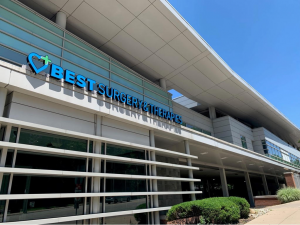Dupuytren’s Contracture
Dupuytren’s disease, or Dupuytren’s contracture, is a condition that causes severe hand deformity by tightening the fascia in the hand. The fascia is layers of tissue found throughout the body that help anchor the skin and keep it from being too loose in certain areas. If the fascia in the palm begins to thicken it can cause contractures and deformities that are diagnosed as Dupuytren’s contracture.
If the condition progresses it can become painful and debilitating, making it hard for patients to perform daily activities. If you’re interested in learning more about this condition and potential treatment options, please read the following information. BEST Health SYstem is here to help and we’ll be happy to answer any questions you have.
Causes
The primary underlying cause of Dupuytren’s contracture is believed to be genetics, although medical researchers are still working to understand how this condition develops. It is generally not believed that Dupuytren’s disease is related to injury or overuse of the hand, but it does become more common with age and is slightly more prevalent among men.
Dupuytren’s contracture is a progressive condition that begins with the formation of nodules under the skin of the inner hand. These nodules can further develop into thick bands and cords that pull on the fingers into visible deformities, or contractures. Dupuytren’s contracture can progress slowly, and in some cases does not need involved treatment, but being proactive about diagnosing and treating this condition can increase the chances of managing it successfully.
Conservative Treatments
There is not currently a cure for Dupuytren’s contracture, but the condition is highly manageable. In fact, for some patients, the disease never progresses beyond visible lumps and never results in physical contracture or deformity.
Conservative treatments that can be effective in slowing the progress of the condition and lessening its severity include:
- Corticosteroid injections
- Gentle range of motion exercises
- Sprinting and bracing of the hand
It is important to exercise caution when performing any stretches or exercises in the hand as it has the potential for injuring the fingers. Like many conditions, practicing a healthy lifestyle can help to reduce inflammation and pain while improving circulation and overall function. Patients should always eat healthy, anti-inflammatory foods, get regular exercise and practice good sleep hygiene.
Symptoms
Dupuytren’s contracture generally begins with symptoms that aren’t very noticeable, but telltale signs to watch include:
- Visible lumps, or nodules, in the palm of the hand that begins to harden over time
- The nodules can eventually lengthen to form longer cords of tough tissue under the skin that can prevent the fingers and thumb from straightening
- Eventually, the hard tissue can lead to contractures in the hand that cause deformity
- This can lead to difficulty gripping objects and performing other basic fine motor skills
Upon noticing any of the above signs it is essential to see your doctor for a diagnosis to avoid Dupuytren’s contracture worsening over time.
Diagnosis
Patients meeting with a doctor regarding hand contractures or deformity should bring a list of symptoms and be prepared to discuss daily activities that are being affected. A physical examination for symptoms related to Dupuytren’s disease typically involves the following steps:
- Review your and your family’s medical history
- Talk to you about your symptoms and how they’re affecting normal activities
- Perform a hands-on evaluation of your hand including measuring modules and testing range of motion
Your diagnosis may involve multiple evaluations over time to determine how quickly the disease is progressing. This condition does not typically require diagnostic imagery to diagnose although it may be ordered in some cases to rule out other conditions. Once a diagnosis has been confirmed, patients can then work with their doctor to design an effective treatment program.
Surgery
Surgery is only recommended in cases of Dupuytren’s disease when the contractures are severely interfering with hand motion and having debilitating effects on quality of life.
Surgical procedures used to treat this condition include fasciotomy and subtotal palmar fasciectomy, which both involve small incisions and either dividing or removing the hardened tissue that is causing deformity in the hand. Either of these procedures can be performed on an outpatient basis with the use of minimally invasive techniques. After surgery, patients will be given thorough instructions for the recovery process and a schedule for resuming normal activities.
Learn About Dupuytren’s Contracture Treatment
To learn more about conservative and surgical treatments for hand conditions such as Dupuytren’s contracture that can help you get back to the quality of life you deserve, contact BEST Health System. Our experienced staff has decades of experience helping patients with a wide range of conditions regain a healthy and active lifestyle.
If you have experienced any of these symptoms or recieved a diagnosis and need treatment, BEST can help. Take the first step towards relief today.
Related Articles
A Map of BEST Health System's Ohio Locations
BEST – The Health System Redefining Care Throughout Ohio BEST Health System is a modern healthcare system with accessible locations throughout the state of Ohio. […]
A Checklist for Car Accident Survivors
The Risk of Driving In the case of a car accident, it only takes a few seconds for everything to change. It has been estimated […]
Osteoarthritis and Spinal Stenosis
What is Osteoarthritis? Osteoarthritis is one of the most common causes of spinal stenosis, according to the American College of Rheumatology. Further research shows that […]
Five Treatment Options to Help with any Type of Tendonitis
Tendonitis, also spelled tendinitis, is an injury caused by inflammation and damage to tendons. In the body, tendons are tough flexible pieces of cartilage that […]
Six Steps to Diagnose a Ganglion Cyst | BEST
A ganglion cyst is a type of noncancerous lump that develops on the back of the hand. This is the most common form of lump […]



